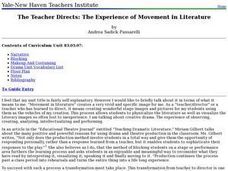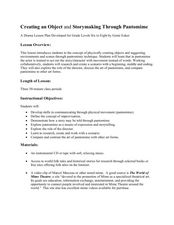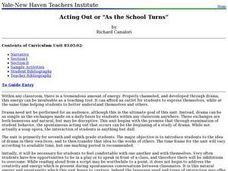Curated OER
Egg Carton Caterpillar
Learners create "egg carton caterpillars" using egg cartons, glue, and basic art supplies in this excellent Art, Science, and Language Arts lesson on caterpillars and butterflies. The caterpillars are displayed for two weeks and then...
Curated OER
Hand And Foot Print Reindeer
Learners create reindeer out of paper cut-outs of their own hands and feet in this fun and quick Art activity for the early-elementary classroom. The lesson may be accomplished as an individual or small group (partner) project.
Curated OER
Heart Shaped Mice
Students create mice using heart shapes, construction paper, yarn, markers, scissors, and glue in this Art lesson for the early-elementary classroom. The activity is an excellent alternative for use during the Valentine's Day season.
Curated OER
Japanese Fan
Students discuss Japanese culture and the functional and artistic uses of fans and create paper fans using watercolors, popsicle sticks, and tape in this Art lesson for the elementary classroom. Can be used as an introduction to...
Curated OER
Scratch Some Fireworks
Students create sheets of "fireworks" using art paper, crayons, black paint, and wooden skewers in this lesson that can be adapted to celebrate any time of the year. The lesson also includes a short introductory discussion on fireworks.
Curated OER
Stand Up Bunny
Students create "stand-up bunnies" for classroom display in this early-elementary Art lesson ideal for the spring months. A bunny template and design ideas are included to aid in the teaching process of this fun and quick lesson.
Curated OER
Sunset Silhouettes
Young scholars create "SUNSET SILHOUETTES" using primary colors, black construction paper, and glue in this elementary-level Art lesson. The lesson extension included with this lesson involves creating a nativity scene and might be...
Curated OER
Van Gogh's Sunflowers
Students create replicas of Vincent Van Gogh's Sunflowers using construction paper, tissue paper, glue, and scissors in this art lesson for the elementary classroom. The flowers can then be displayed in the room as a class bulletin board.
Curated OER
Blessing Boxes
Students create "Blessing Boxes" to show what they are thankful for in this Art lesson ideal for the Thanksgiving holiday. The materials needed include empty (and clean) milk cartons, brown construction paper, and magic markers.
Curated OER
Egg-sceptional
Young scholars design colored Easter eggs in this simple Art lesson for the elementary classroom. The dye is created using almost boiling water and should be done by the teacher. This lesson is ideal for the spring-time months and...
Curated OER
Handprint Ghosts
Young scholars create handprint ghosts using construction paper, paints, crayons, paper plates, and paper towels in this Art lesson for the early-elementary classroom. An ideal craft activity for the classroom before the Halloween holiday.
Curated OER
Pop Up Card
Students design and create pop-up greeting cards for a special occasion in this art lesson for Kindergarten through 8th grade classrooms. The lesson includes resource links for pop-up "arm" ideas and can be accomplished in one day.
Curated OER
Smiling Flowers Bulletin Board
Students create paper plate flowers using basic art supplies, digital pictures of themselves, and "stems and leaves" in this Art-based lesson that incorporates digital technology. The lesson is ideal for use during the spring months.
Curated OER
The Teacher Directs: The Experience of Movement in Literature
Experience movement in literature. High schoolers are introduced to new vocabulary related to drama and theatre. In groups, they use a piece of literature and develop their own skit to act out in front of the class. As a class, they...
Curated OER
Programs for Shakespeare's Plays
Young scholars design theater programs which show their understanding of William Shakespeare's plays. They design original art to include in the programs.
Curated OER
Witchcraft
Tenth graders develop response to witchcraft from a historical and cultural perspective. They evaluate the use of ceremonies and rituals in witchcraft. They develop a character and develop use of genres and styles of drama. They role...
Curated OER
Reader's Theater
Conduct a Reader's Theater. Third, fourth, and fifth graders rewrite books with a baseball theme to a Reader's Theater format. They form groups of four or five, practice reading the script, and then perform it for an audience.
Curated OER
Storymaking Through Pantomime
Middle schoolers explore performing arts by participating in a role-play activity. In this storytelling lesson, students utilize their physical expressions to particpate in a pantomime performance. Middle schoolers evaluate performances...
Curated OER
Colors of Gray
Students view a film about theatres in Chicago. They discover how performing arts can be enjoyed by all ages and how one becomes involved in performing in theatre. They answer questions and discuss to end the lesson.
Curated OER
Goldilocks and the Three Bears Pantomime
Students investigate acting and performing arts by portraying a story in class. For this pantomiming lesson, students read the story Goldilocks and the Three Bears, and discuss the characters amongst themselves. Students portray the 4...
Curated OER
Acting Out or "as the School Turns"
Students learn the idea of drama in their own lives; and then transfer that idea to the works of others in this series of lessons. They discuss the question of identity.
Curated OER
Music in South India-Kerala
Students identify various instruments and styles of music from South India-Kerala. In this music lesson, students discover main languages of South India and the Kathakali dance drama. Students discuss the types of singers and dancers in...
Curated OER
Fifties/Sixties Musical Playwriting Workshop
Students write a coherent script based on characterization, theme, conflict and emotional tone as found in the songs' lyrics and develop an understanding of the enjoyment that comes through discipline and hard work leading toward a...
Curated OER
Observing To Make Meaning
Young scholars infer meaning while viewing a scene of Pinocchio without sound. They write a plot summary of the excerpt of Pinocchio, watch the same scene with sound, and compare their assumptions with the actual performance.

























